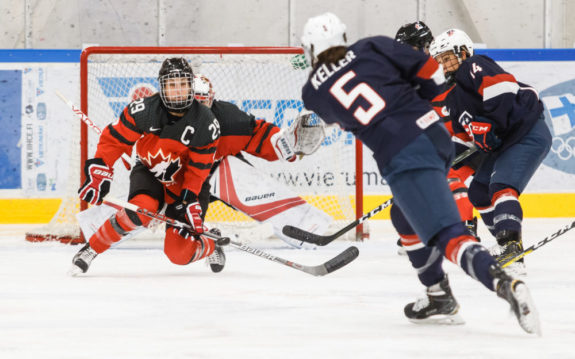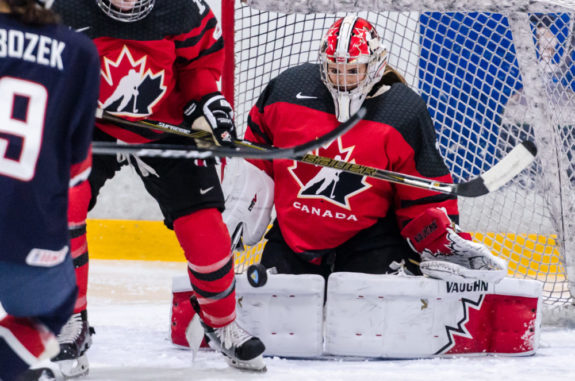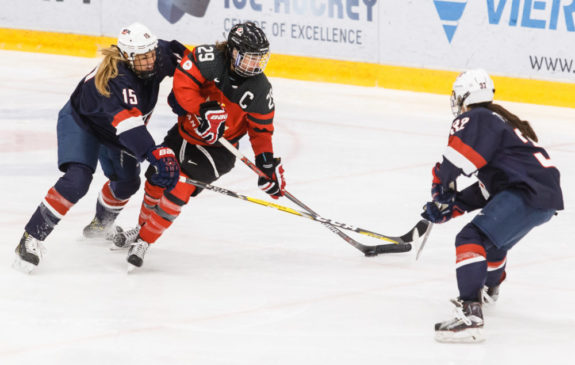For the second straight year, the U.S. women’s team took first at the Four Nations Cup. Though they dropped a decision to Canada in the round-robin stage, they turned it on when it mattered most and grabbed a 5-3 decision over Team Canada in the gold medal match.
In Friday’s loss to Canada, a warm-up for the main event, it was a power play goal that made the difference for Canada despite the U.S. winning the shots battle 32-17. The shot differential stayed largely the same in a tight gold medal game that saw the U.S. open up a 5-2 lead with three third-period goals.
Meanwhile, amid some controversial roster decisions, Sweden fell 2-1 to Finland, who were skating on home ice in Jarvenpaa, Finland.
Here are five takeaways from the 2016 Four Nations Cup.

1. The U.S. Controlled Play
Though it was by no means a one-sided affair in either game, the U.S. nearly doubled up on shots against Canada in both meetings. Special teams skewed that some, but at even strength, the U.S. was frequently able to establish a strong forecheck.
In the first game, special teams played a larger role with the U.S. grabbing seven power plays to just four for the Canadians. However, Haley Irwin grabbed a power-play goal in the third that would prove to be the game-winner for Canada.
But the potency of the U.S. forecheck will matter for both teams looking ahead. The Americans didn’t always get the highest quality opportunities, but the Canadian defense struggled, allowing quality chances off the rush and struggling to get strong coverage in front of their own net.

2. Canada’s Goaltending
Coming off an outstanding goaltending duel at the 2016 World Championship, the gold medal match at Four Nations ran in stark opposition to that contest.
The round-robin and championship games were back-to-back games, creating a difficult decision for coaching staffs. Do you run your best goaltender in back-to-back games or split the workload and hope a fresh netminder gives you an edge?
For the U.S., it was Rigsby all the way.
But Canada changed things up for the gold medal match, moving from Genevieve Lacasse in Friday’s game to Calgary Inferno goaltender Emerance Maschmeyer, who was in net for Canada during that thrilling World Championship game.
While there was plenty of criticism available to many on Canada’s side, Maschmeyer’s final numbers weren’t outstanding with an .828 save percentage (though it’s worth noting that was better than Rigsby’s .813 in the gold medal game). But any criticism of her performance has to be tempered with a look at how she was repeatedly hung out to dry.
On the first goal, no one cleared out the rebound grabbed by Emily Pfalzer. The second goal she might want back, but the third goal, though it was a slapshot from the high slot, no one bothered to do anything about Hilary Knight creating a fantastic screen inches from Maschmeyer’s face. The fourth goal was a Knight breakaway and the fifth had Laura Fortino completely missing coverage on Kelli Stack, leaving her open for a tap in on the weak side.
The lapses for Canada weren’t goaltending gaffes, but more frequently lapses in defensive-zone coverage that made life difficult on Maschmeyer.

3. Special Teams
Though there was only one goal scored on special teams between the two games, it loomed large, with opportunities coming frequently. Considering that the teams actually split a two-game series 1-1 (though the U.S. won the important one), it shows what a huge role special teams play in a tournament like this.
Canada took some sloppy penalties, but they were the ones who capitalized and stole a game. The U.S. power play, with more opportunities, was less effective and that’s something that’s tough to live with in a short tournament. As happened in the first game, special teams have the power to tilt the tables.
4. Noora Raty’s Return
Stepping back from the gold medal game (there were teams other than the Canada and U.S. at the Four Nations Cup), Noora Raty returned to the Finnish net for the first time since last year’s Four Nations Cup and that came after she briefly announced her retirement after the 2014 Sochi Olympics before signing with a men’s team in March of that year. (Though she has played in a total of four international tournaments since Sochi.)
Raty is the kind of player who has given her teams a shot at winning through her play repeatedly. That’s huge for any team looking to upset either of the top dogs. Raty performed well and was instrumental in helping Finland to take the bronze on home ice. That should be a promising sign for the Finland at the World Championship if Raty stays with the national team.
5. Women’s League Play Matters
The growth of the NWHL and CWHL is starting to have a bigger impact on international play. Like with men’s international competition, players who come from the same team and have some instant chemistry and can find success in these kind of short tournaments. That’s particularly true of a tournament like the Four Nations Cup where players have a relatively short amount of training time before the tournament, unlike Olympic years where players are together throughout the fall and winter.
That was seen with the U.S. in the connection between Knight and Decker — both playing for the Boston Pride — or for Canada between Sarah Davis and Jessica Campbell. It was a factor before, but it could become an increasingly important piece of the depth chart when you can get that instant chemistry rolling. If that kind of connection continues, it’s possible it could play a factor in the inevitable late roster additions when a player like Amanda Kessel suffers an injury and has to be removed from the roster shortly before the tournament begins.
The next major international tournament will come shortly after the close of the CWHL season and shortly before the end of the NWHL season, when eight teams converge in Plymouth, Michigan on March 31 for the 2017 World Championship.